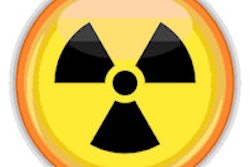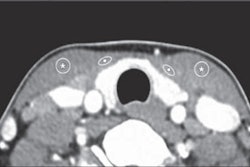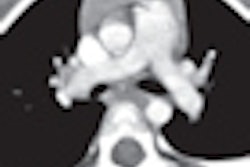SAN FRANCISCO - When ordering CT exams, put the calculator away, forget about radiation risk, and focus on whether the scan is necessary, said a leading medical physicist on the opening day of the International Society for Computed Tomography (ISCT) 2011 annual meeting.
The risks from CT are probably negligible at the level of the doses likely to be used -- and in any case, they are outweighed by the risk of not doing a necessary exam, said Cynthia McCollough, PhD, a professor of medical physics at the Mayo Clinic in Rochester, MN.
All true, said another researcher, but most studies show a small but statistically significant increase in cancer incidence following excessive radiation exposure.
Wrong question
Doctors shouldn't even consider the risk of cancer induction when ordering a CT exam, McCollough told ISCT attendees. The risks of low-dose and low-dose-rate ionizing radiation are not only uncertain, they're potentially not even present, she said.
"Some of the epidemiological data from the [atomic] bomb survivors, for example, are not the same type of dose deliveries," she said.
Any actual risk is too small to estimate with any certainty, especially at the level of the individual patient, according to McCollough. And the method for assessing risk is flawed. Risk estimates are based on the linear no-threshold model, which is increasingly found to be inconsistent with observed behavior at the molecular, cellular, and tissue levels.
One example, a 25-year study of radiation workers in Britain (Muirhead et al, British Journal of Cancer, January 13, 2009, Vol. 100:1, pp. 206-212), found no significant increase in cancer rates at doses approaching 100 mSv and higher per year over the course of the workers' careers, McCollough said.
In the U.S. as well, industrial exposure standards are high and the cancer induction risks, so far, have been difficult to establish. In the radiation protection field, workers in the U.S. are permitted to be exposed to 50 mSv over 40 years of their working lives, an amount that is considered a safe dose in the workplace if not in the CT scanner.
"I really get concerned with qualitative words like high- and low-dose -- calling any exam over 3 mSv 'high-dose,' for example," she said. Because it's not. Environmental radon exposes people to 3 to 10 mSv per year "just for living on planet Earth," she said. And cancer clusters in the U.S. bear no geographic relation to areas of high radon levels.
"I believe very strongly that it has not been scientifically demonstrated that there is any risk from radiation below 100 mSv," McCollough said. "Is radiation a carcinogen? Absolutely." But at CT dose levels, which range from about 1 to 20 mSv, the data aren't clear enough to draw conclusions, she said.
In a 2002 article by based on Japanese atomic bomb survivor data published in the American Journal of Roentgenology, increased risk for the most readily inducible cancer from radiation -- leukemia -- could not be clearly discerned for individuals who received bone marrow doses below 200 mSv, McCollough said of the study by Cohen et al.
LNT theory's rough road
The linear no-threshold (LNT) model by which radiation risk is currently estimated is rife with problems, beginning with its presumption that if one doubles the dose, one doubles the effect, she said. No distinction is made in the type and rate of radiation delivery, and, in fact, LNT doesn't tie radiation dose to cancer induction very well.
"The basis [for radiation damage] in biology is very nonlinear," she said. "The dose may be distributed linearly, but what the organism does with that exposure is extremely nonlinear."
The presence of a repair mechanism is another fact LNT doesn't consider; otherwise, radiation therapy wouldn't work, McCollough said. Such therapy is typically provided over a six-week period to give the body time to repair.
A study in Radiology (Tubiana et al, April 2009, Vol. 251:1, pp. 13-22) found LNT to be inconsistent with biological and experimental data using radiation. In addition, apoptosis, or "cell suicide," has been found to be a robust mechanism by which damaged cells are eliminated before they can progress to cancer.
Studies indicate a qualitative difference in the biological response to low-dose and low-dose-rate irradiation compared to high doses and dose rates. This contradicts LNT theory, McCollough said. LNT dictates there should be no qualitative differences in response between high and low doses, only quantitative.
The fact that this is not the case has already been widely recognized by the adoption of a dose and dose-rate effectiveness factor (DDREF) to improve the fit of linear risk models to observed data, she said.
In fact, most substances that are dangerous in large amounts are safe or even beneficial in small or dilute amounts -- think of taking an acetaminophen tablet for a headache, she said. Overdoses may lead to liver damage, but at recommended doses acetaminophen is not harmful. But LNT automatically assigns risk to any nonzero dose.
Debate raged in mammography for years with assertions that repeated mammography would cause cancer, McCollough said. But the approximate 30% decline in breast cancer mortality since the 1970s coincides with the advent of widespread screening, a finding backed by multiple data sources.
In any case, risk estimates for less than 100 mSv are meaningless, McCollough said. The Health Physics Society recommends against quantitative estimation of health risks below an individual dose of 50 mSv in one year, or a lifetime dose of 100 mSv above the dose received from natural sources.
The Health Physics Society concluded that "below 50 to 100 mSv, risks of health effects are either too small to be observed or are nonexistent," she said. Similarly, the American Academy of Sciences' 2006 Biological Effects of Ionizing Radiation (BEIR) VII phase 2 report states that "at doses of 100 mSv or less, statistical limitations make it difficult to evaluate cancer risk in humans."
In crafting these more recent reports, the French Academy of Sciences and the American Academy of Sciences were all working with the same available data, McCollough noted. Yet while the French report included data finding no evidence of harm from low doses, the American report did not.
"The U.S. evaluation tossed that data out, while [the French] came to a very different conclusion than the U.S.," McCollough said -- for example, not endorsing LNT, and validating empirical risk relationships only for doses greater than 150 mSv.
It all comes down to the benefit of the scan versus the potential effect, she said. The biological effects of radiation could be good, bad, or neutral, but they are too small to be convincingly demonstrated. Moreover, risk depends on many factors, including age, gender, genetic predisposition, other stressors, and diet.
It is illogical to embrace LNT for low-dose medical exposure while rejecting it for occupational exposure, she said.
"The risk is low, it can't be calculated with certainty, [and] it may be zero, so if the exam is justified, order it and do it as carefully as possible," McCollough said. That means ensuring that the exam is appropriate, it does not have equally effective alternatives, and the radiation dose is optimized.
McCollough cited research by Geilijns et al from the University of Leiden that found that the mortality risk associated with radiation from a coronary CT angiography scan was vastly outweighed by the total risk of conventional angiography, where there are risks of infection and even death due to the invasive nature of the procedure.
"In the end, remember, there is a risk for failing to perform a medically appropriate CT," McCollough said.
Large studies suggest risk from medical doses
Dissenting from McCollough's conclusions in another presentation, Dr. Andrew Einstein, PhD, director of cardiac CT research at Columbia University Medical Center, noted similar conclusions in three of the largest research projects on the topic:
- Hiroshima atomic bomb survivor data (Preston DL, Radiation Research, July 2007, Vol. 168:1, pp. 1-64)
- The 15-country collaborative study of cancer risk among radiation workers in the nuclear industry (Cardis et al, Radiation Research, April 2007, Vol. 167:4, pp. 396-416)
- Relative risk of childhood cancer from in-utero radiation (Doll et al, British Journal of Radiology, February 1997, Vol. 70, pp. 130-139)
That is, these studies all came up with an approximate 2% rate of excess cancers attributed to radiation exposure. Most studies conclude that there is a risk, Einstein said, adding that many others find no effect.
Although the issue is far from settled, several large epidemiologic studies are under way that will provide a better understanding of cancer risks from CT, Einstein said. Six studies from Ontario, Canada, to the U.K., Australia, Sweden, and France are currently studying the effects of radiation exposure in 810,000 patients, and a meta-analysis is planned, he said.



















